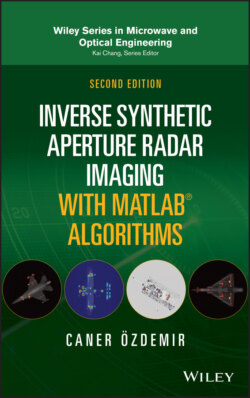Читать книгу Inverse Synthetic Aperture Radar Imaging With MATLAB Algorithms - Caner Ozdemir - Страница 66
2.6.1 Continuous Wave
ОглавлениеA CW radar system transmits radio wave signals at a particular frequency. If both the radar and the target are stationary, then the frequency of the received CW signal is the same as the transmitted signal. On the other hand, the returned signal's frequency components are shifted from the transmitted frequency if the target is in motion with respect to the radar. This type of shift in the frequency spectrum is called Doppler frequency shift and plays an important role in finding the velocity of the target in most radar applications. The concept of Doppler frequency shift is also important for ISAR imaging. We shall see the use of Doppler frequency shift concept in Range‐Doppler ISAR imaging applications in Chapter 6.
The time‐domain signal of the CW radar is as simple as
(2.42)
where fo is the operating frequency. The frequency spectrum of this CW signal can be readily found by applying the forward Fourier transform (FT) operation to Eq. 2.42 to get
(2.43)
An example of a CW radar signal is shown in Figure 2.9. In Figure 2.9a, a purely sinusoidal signal that has a frequency of 1 kHz is drawn. The frequency spectrum of this signal is plotted in Figure 2.9b where two impulses at fo = ±1 kHz can be easily seen.
As opposed to pulsed radar systems that use the time delay of the transmitted pulses to find the range of the target, CW radars measure the instantaneous rate of change in the target's range from the radar. This change causes the Doppler shift in the frequency content of the returned EM wave due to the motion of the radar, target, or both. One of the best uses of CW radar is the police radar system that estimates the speed of motor vehicles. A demonstration of CW police radar is shown in Figure 2.10. Assuming that the radar is stationary and transmitting a CW signal with a frequency of fo, the frequency of the reflected wave from a stationary target is the same as the transmitting frequency fo. If the target is approaching the radar, the frequency of the reflected wave increases with a shifted amount of fD which is known as Doppler frequency shift (Mahafza 2005) and is given by Figure 2.10b:
Figure 2.9 An example of CW radar waveform in (a) time domain, (b) frequency domain.
(2.44)
Here, vr is the radial speed of the moving target, and λo is the wavelength corresponding to the frequency of the transmitted wave. In a dual situation, if the target is moving away from the radar, the frequency of the reflected wave is altered such that the Doppler frequency shift produces a negative value. Therefore, the wavelength of the reflected wave increases and the frequency decreases with an amount of fD (see Figure 2.10c).
Figure 2.10 Operation of police radar: (a) returned wave has the same frequency as the transmitted signal for the stationary target, (b) returned wave's frequency is increased for the approaching target; (c) returned wave's frequency is decreased for the target going away.
The use of CW waveform in various radar applications provides the following advantages. First of all, the radars that use CW waveforms are easy to manufacture, thanks to their simple waveform shapes. Second, they can detect any target on the range as far as the power level permits. Therefore, there is no range constraint for detection. In addition, they can be used in both very low‐frequency band (e.g. radio altimeters) and very high‐frequency band (e.g. early warning radars).
CW radars have the following disadvantages. They cannot estimate the range of a possible target. Range is normally measured by the time delay between different pulses created by the radar. In CW radars, however, the waveform is continuous and not pulsed. Furthermore, they can only detect moving targets. Reflected energy from stationary targets is filtered out since their basic operation is based on measuring the Doppler shift in the frequency.
Another disadvantage comes from the fact that they maximize the power consumption since they continuously broadcast the outgoing signal.
